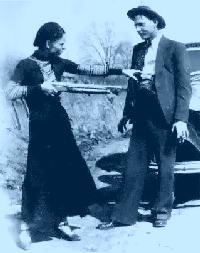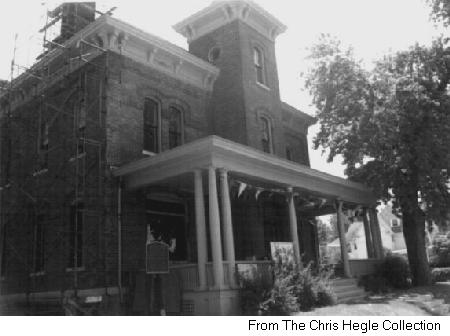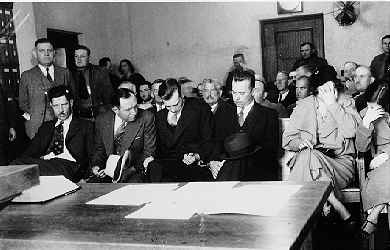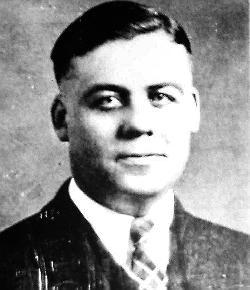
At this moment, Agents Jay Newman, W. Carter Baum and a local constable named Christiansen pulled into the driveway. As they pulled next to his car, Baby Face jumped out and ordered the agents and the officer out at gunpoint. He then proceeded to open fire on all three, killing Baum on the spot. The hostages dove for cover. After unloading his weapon at everything in sight, Nelson took the Ford the agents had been using and headed south at high speed.
Back at the lodge, the three gangster's women, who had been hiding in the basement, surrendered and were arrested. As Dillinger, Van Meter and Hamilton raced toward St. Paul after the battle, they were spotted by waiting lawmen, who began chasing the stolen Packard the gang was driving. As they exchanged fire one of the police bullets caught Hamilton in the back.
Eventually eluding their pursuers, they hijacked another car and headed for Chicago with the wounded Hamilton. Nelson holed up at the Lac Du Flambeau Indian Reservation until a few days had passed, then made his way to Marshfield, Wisconsin, and obtained a car. The women were jailed in Madison.
The entire raid came to be seen by the public as a disaster, bringing heavy criticism on the FBI and Hoover. As the controversy raged, five days later, Dillinger and Van Meter finally found medical attention for Hamilton, through Doc Barker of the equally notorious Barker gang. In the end, Hamilton died of his wound and was buried in a gravel quarry.
On May 5, 1934, spurred on in part by the lawlessness of the likes of Dillinger, The House Of Representatives passed numerous laws covering crimes typical of those committed by the motorized bandits of the time. While Dillinger went into hiding in Calumet City, Illinois, Bonnie and Clyde were killed by a posse outside Gibsland, Louisiana, on May 23, 1934.

John Dillinger, Public Enemy No. 1, lived up to the title bestowed upon him on his birthday of June 22nd, 1934, by J. Edgar Hoover's Division of Investigation. The popular bandit cemented his national notoriety when on Saturday, March 3, 1934, around 9 a.m. he broke out of the Lake County Jail (the so-called escape-proof jail) in Crown Point, Indiana. Dillinger had been in Crown Point since his extradition from Arizona in January awaiting trial for the alleged murder of East Chicago Police Officer O'Malley. On that morning, using a gun which had been carved out of wood from a washboard and blackened with shoe polish, he took two of his keepers hostage. After locking up the warden, Lou Baker, and getting the drop on the turnkey and one of the national guardsmen there to prevent such a breakout, Dillinger commandeered two machine guns. After freeing a fellow inmate, he ultimately made his way out a side door of the "heavily fortified" jail and proceeded to make his getaway in the sheriff's V-8 Ford.
Dillinger's bold escape set off a flurry of reports of sightings across the midwest in the days that followed. The escape caused a political uproar. In the escape he had made one vital mistake, in driving the stolen sheriff's car across the state line toward Chicago, he had violated the one law that could involve federal agents at the time, the National Motor Vehicle Theft Act. It was an error that would set the stage for his ultimate demise outside of a Chicago theater four months later.
 Dillinger became a national news item during his incarceration in the Pima County Jail in Tucson, Arizona. Newspapermen and photographers poured in from around the country. While Dillinger and his gang gave interviews, there was much legal wrangling behind the scenes over which state would win extradition. He was eventually extradited to Indiana to stand trial for the O'Malley killing. The other three men (along with Mary Kinder) were sent to Ohio. The three menwere sent to Ohio to be tried for killing Sheriff Sarber in the Lima breakout. Mary Kinder was released to Indiana authorities for her possible involvment in the Michigan City escape. Nothing ever came of it but she was watched by authorities very closely. Billie Frechette, arrested with Dillinger, was released.
Dillinger became a national news item during his incarceration in the Pima County Jail in Tucson, Arizona. Newspapermen and photographers poured in from around the country. While Dillinger and his gang gave interviews, there was much legal wrangling behind the scenes over which state would win extradition. He was eventually extradited to Indiana to stand trial for the O'Malley killing. The other three men (along with Mary Kinder) were sent to Ohio. The three menwere sent to Ohio to be tried for killing Sheriff Sarber in the Lima breakout. Mary Kinder was released to Indiana authorities for her possible involvment in the Michigan City escape. Nothing ever came of it but she was watched by authorities very closely. Billie Frechette, arrested with Dillinger, was released.
On January 30, the plane carrying Dillinger and his guards arrived at Chicago Municipal Airport (Midway). Waiting at the airport was a large contingent of police, in addition to the Dillinger Squad. With sirens wailing, the car carrying the outlaw was accompanied by a caravan of vehicles and motorcycle cops. Arriving at the sheriff's office in Crown Point, Indiana, he was greeted by numerous reporters with whom he cracked jokes. Photographers convinced Dillinger and Prosecutor Estill to pose, Dillinger cheerfully leaning his arm on his prosecutor's shoulder, with the sheriff looking congenially on. Dillinger closely watched the photographers and timed a pre-arranged signal with his hand that was to set his escape efforts into action.

The day after the robbery a man known as Jimmy Lawrence met his girlfriend, Polly Hamilton, for a date. He had been seeing her for two weeks. She was renting out a room from a Romanian immigrant named Anna Sage. Sage was currently facing deportation proceedings, stemming from her convictions resulting from charges related to her running brothels in Gary, Indiana, and East Chicago. Only Sage knew that Jimmy Lawrence, was in fact, John Dillinger. While living quietly in his new identity, the manhunt was continuing. Hoover had appointed Samuel Cowley to head up the investigation in Chicago.
On July 20, 1934, Anna Sage contacted acquaintance Martin Zarkovich, an East Chicago police sergeant, and offered to reveal the whereabouts of John Dillinger in return for both the reward money and help in blocking her deportation. Zarkovich contacted Melvin Purvis. At subsequent secret meeting with Purvis and Cowley she outlined her offer and received assurance that they would help with her deportation problem. She told them that she would be going with John and Polly to the movies at the Marbro the following evening.
On July 22, all available agents were briefed on the setup. At 5:30 p.m., Sage called and confirmed that they would attend a movie that night at either the Marbro, or the Biograph theater. Secondary plans were quickly made to have Purvis and Agent Ralph Brown stake out the Biograph. Spotting Dillinger and the women arrive at the Biograph, where Manhattan Melodrama featuring Clark Gable was showing, Agent Brown immediately called Cowley. Agents quickly surrounded the theater. Purvis was stationed left of the entrance.
Fifteen agents were selected, eleven of whom would fly, the other four were to drive. Once there, they joined forces with another group who had flown in from St. Paul. The leader of this group, Assistant Director Hugh Clegg, assumed overall command of the operation. Expecting to begin the raid at 4 a.m., it was learned from Voss's wife that Dillinger and the others had moved their departure up to that evening. The agents located five vehicles and drew up plans to surround the lodge. Three agents in bulletproof vests were to come through the front door while others took up positions around the lodge.
On the trip to the lodge, two of the cars broke down requiring some of the agents to ride on the running boards of the remaining cars in the extreme cold. Just before 8 p.m., they arrived at their destination and immediately blocked the driveway with two of the cars. They then began to move in on foot.
As they neared the lodge, they were suddenly confronted by barking dogs, which Voss had failed to warn them of. The agents rushed into position, thinking that those inside had been alerted. At just this moment, three of the visitors to the lodge headed to their car, while two of the lodge employees came outside to check on the barking. As the three men began backing their car out, the agents opened fire believing it was gang members getting away. One of the occupants of the car was killed instantly.
Hearing the gunfire outside, the gang quickly moved into place and opened fire, Nelson shooting from the cabin. Within moments, as previously planned, Dillinger, Van Meter and Hamilton, followed by Carroll went out the back of the lodge. They headed down to the adjacent lake and escaped to the north on foot. Nelson soon escaped, heading the opposite direction along the shore. While he headed south, the others soon located vehicles to steal, and got away.
Forcing his way into a nearby lodge owned by a man named Koerner, Nelson was holding the occupants hostage when Emil Wanatka and his brother-in-law arrived in front with the two employees from Little Bohemia. Nelson commandeered their vehicle and prepared to leave with Emil and Koerner as hostages, unaware that Koerner had already called the FBI when he noted Nelson's suspicious arrival.
